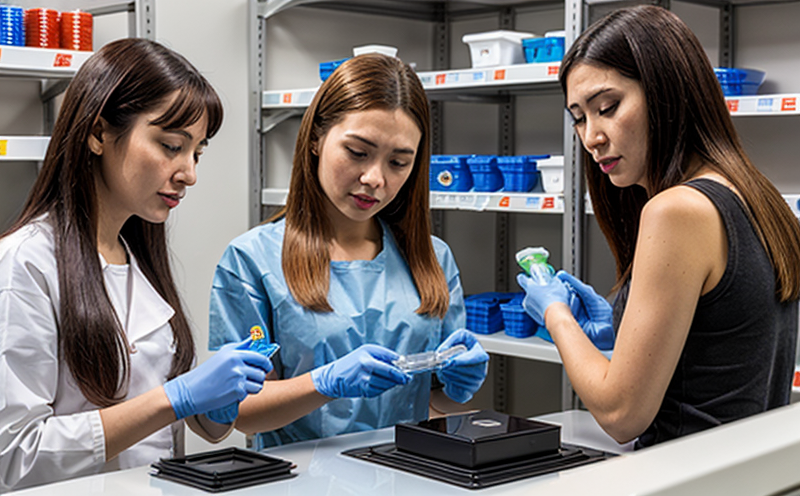BS EN ISO 15377 Optical Properties Testing of Consumer Plastics
The British Standard (BS) and European Norm (EN) ISO 15377 standard for the determination of optical properties in plastics materials is a critical component of modern quality assurance processes. This comprehensive testing ensures that consumer products made from plastic materials meet stringent light transmission, reflection, and color parameters.
The optical properties of plastics are essential in various applications ranging from packaging to electronics. For instance, clear plastics used in food containers need to transmit light without distortion or loss, while colored plastics must accurately match their intended hues as perceived by the consumer. This standard addresses these specific needs through a series of rigorous tests that measure how light interacts with different types of plastic materials.
The process begins with selecting appropriate specimens representative of the product being tested. These samples are then prepared according to ISO 15377 guidelines, which specify conditions such as temperature and humidity levels during preparation to ensure accurate results. Afterward, these samples undergo measurement using specialized equipment calibrated against international standards.
One key aspect of this testing involves measuring light transmission through the plastic sample. This is done by shining a standardized light source onto one side of the specimen and recording how much light passes through it on the other side. Another important parameter measured is the reflectance, which quantifies how well the surface of the material reflects incoming light. These measurements are crucial for ensuring that packaging remains clear or maintains its color integrity throughout use.
The results from these tests provide valuable insights into the performance characteristics of plastic materials in various environments and applications. They help manufacturers make informed decisions about selecting appropriate grades of resin, optimizing production processes, and improving overall product quality. Additionally, compliance with this standard is often required by regulatory bodies to ensure safety standards are met.
For instance, packaging intended for food contact must adhere strictly to certain light transmission levels to prevent contamination or degradation caused by excessive exposure to sunlight. Similarly, electronic components embedded within plastic casings need precise reflectance properties to function correctly without interference from ambient lighting conditions.
- Light Transmission: Measures the amount of visible light that passes through a sample.
- Reflectance: Determines how much incident light is reflected off the surface of the material.
- Color Measurement: Assesses the color appearance and consistency across different samples or batches.
Why It Matters
The importance of optical property testing in consumer plastics cannot be overstated. Accurate measurement ensures that products maintain their intended functionality over time, which directly impacts customer satisfaction and brand reputation.
For instance, packaging designed to protect fresh produce during transport relies heavily on its ability to transmit light while keeping contaminants out. If the plastic film used does not meet specified transmission levels, it could lead to premature spoilage or damage due to overexposure to sunlight. On the other hand, electronic devices encased in opaque plastics may suffer from overheating issues if they cannot dissipate heat efficiently through radiation.
Compliance with ISO 15377 also plays a vital role in regulatory compliance and market access for manufacturers operating internationally. Many countries have regulations requiring products to pass specific optical property tests before being sold within their borders. For example, some jurisdictions mandate that medical devices be made from materials that do not alter the color of tissues when exposed to certain wavelengths of light.
In summary, precise measurement and adherence to ISO 15377 help protect consumers by ensuring safe, functional products while supporting manufacturers in meeting global standards and fostering trust among stakeholders.
Quality and Reliability Assurance
- Consistency: Ensures that each production batch meets the same high-quality standards for optical properties.
- Prediction of Performance: Allows manufacturers to predict how well their products will perform under various environmental conditions.
- Regulatory Compliance: Helps ensure that all products comply with relevant safety and quality regulations.
By incorporating ISO 15377 into their testing protocols, manufacturers can significantly enhance the reliability of their products. This not only improves customer satisfaction but also reduces the risk of recalls or lawsuits related to product failures.
In addition to these benefits, regular optical property testing allows companies to identify trends in material performance over time, enabling them to make data-driven decisions about process improvements and new product development.
Customer Impact and Satisfaction
Optical property testing of consumer plastics has a direct impact on customer satisfaction by ensuring that products function as intended. For example, clear plastic containers for beverages must provide optimal clarity to enhance the visual appeal of drinks while maintaining their transparency during use.
Manufacturers who invest in thorough optical testing can expect improved product performance and enhanced brand loyalty among consumers. By delivering consistently high-quality products, companies build a strong reputation that encourages repeat purchases and positive word-of-mouth recommendations.
In conclusion, adherence to ISO 15377 demonstrates a commitment to quality assurance and contributes significantly towards meeting customer expectations in the marketplace.





